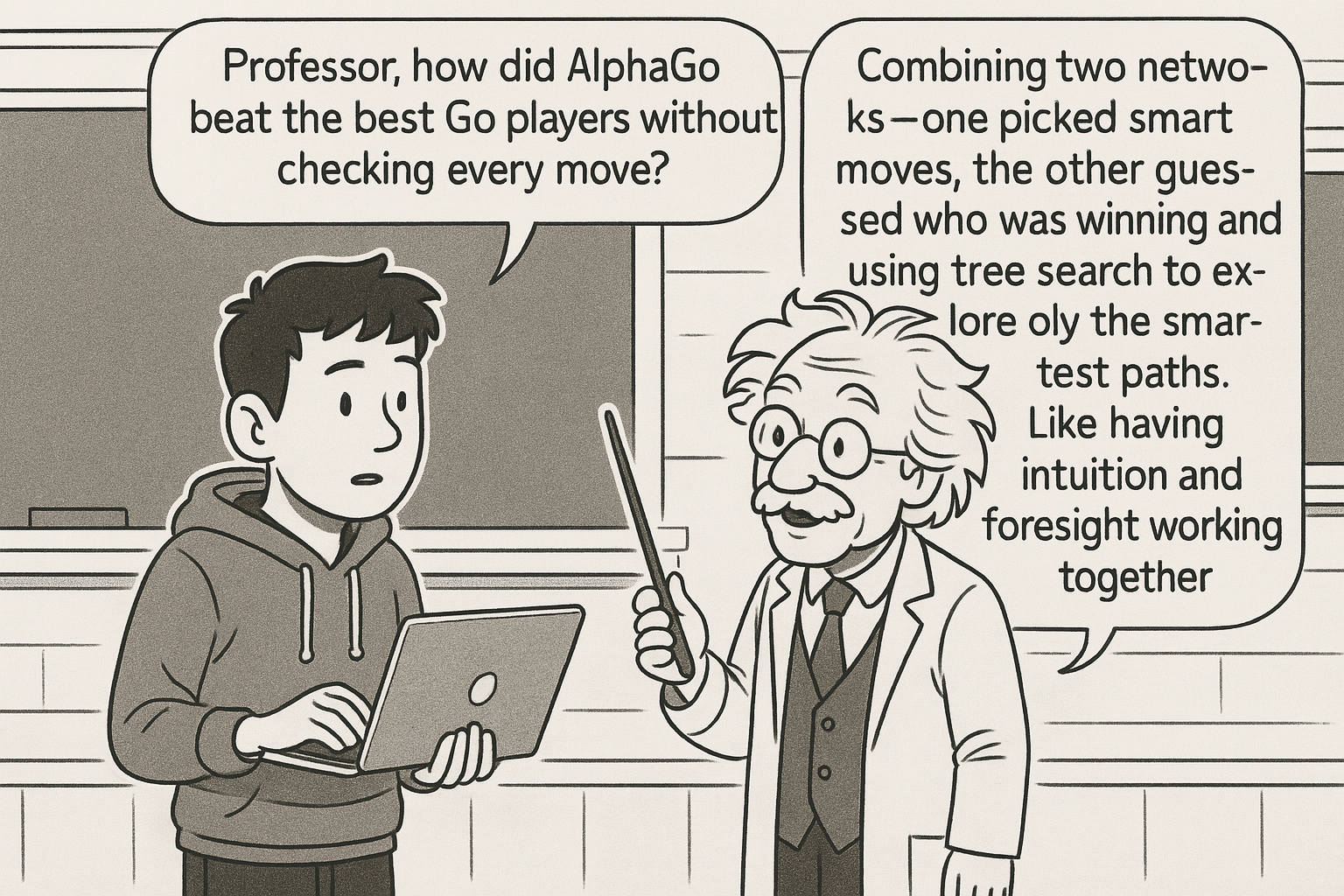Introduction
In 2016, researchers at DeepMind published "Mastering the Game of Go with Deep Neural Networks and Tree Search" introducing AlphaGo - the first artificial intelligence system to defeat a professional Go player. This achievement was considered impossible by many experts, as Go had remained unconquered by computers for decades due to its astronomical complexity and reliance on intuitive pattern recognition rather than brute-force calculation.
"Deep learning combined with smart search can master tasks that seemed to require purely human intuition."
Core Ideas
AlphaGo's breakthrough came from combining two powerful technologies: deep neural networks and Monte Carlo Tree Search (MCTS). The system used not one but two specialised neural networks working together like a tag team.
The first network, called the policy network, learned to suggest promising moves by studying millions of games played by human experts. Think of it as an experienced player's intuition about which moves "feel right" in any given position. This network was trained using supervised learning on 30 million positions from the KGS Go Server, where amateur and professional players compete online.
The second network, the value network, learned to evaluate how good any board position was for winning the game. Instead of calculating every possible future move (which would take longer than the age of the universe), this network could look at a position and estimate the winning probability, much like an experienced player can sense whether they're ahead or behind.
The magic happened when these networks were combined with Monte Carlo Tree Search, a technique that explores the most promising paths through the game tree. Rather than examining every possible move sequence, MCTS uses the policy network to focus on moves that seem reasonable and the value network to evaluate positions without playing them out completely.
The training process involved three distinct phases. First, the policy network learned from human expert games through supervised learning. Then, the network was improved through reinforcement learning by playing millions of games against slightly different versions of itself. Finally, the value network was trained to predict game outcomes from the self-play games.
Breaking Down the Key Concepts
To understand how AlphaGo works, imagine you're learning to play Go from the world's best teachers. The policy network is like having a grandmaster constantly whispering suggestions about which moves to consider. It doesn't guarantee the best move, but it dramatically narrows down the options from 361 possible positions to perhaps 10-20 reasonable ones.
The value network acts like another grandmaster who can glance at any position and immediately tell you, "You're winning by a comfortable margin" or "This looks difficult for you." This instant evaluation saves enormous amounts of calculation time.
Monte Carlo Tree Search is the decision-making process that brings everything together. Instead of trying to calculate every possible game to the end (impossible even with supercomputers), MCTS explores the game tree intelligently. It spends more time examining paths that the policy network suggests are promising and uses the value network to estimate outcomes without playing games to completion.
The self-play training was particularly clever. Once AlphaGo reached a reasonable level, it stopped learning from human games and began playing millions of games against itself. Each version would play against slightly modified versions, constantly discovering new strategies and improving. This approach allowed AlphaGo to transcend human knowledge and develop novel playing styles.

Results and Significance
AlphaGo's victory over Lee Sedol, one of the world's strongest Go players, in March 2016 was a watershed moment for artificial intelligence. The match wasn't even close - AlphaGo won 4 games out of 5, demonstrating consistent superiority rather than lucky wins.
Go had been considered the "holy grail" of AI challenges because it required intuition, pattern recognition, and long-term strategic thinking - qualities that seemed uniquely human. The game's complexity was staggering: there are more possible Go positions than atoms in the observable universe.
AlphaGo proved that deep learning could tackle problems requiring what we call "intuition." This opened doors for applying similar techniques to other complex domains like medical diagnosis, scientific research, and business strategy. The combination of neural networks with tree search became a template for solving previously intractable problems.
The technical innovations had immediate impact across the AI research community. The policy and value network architecture influenced game AI development, while the self-play training methodology was adopted for various applications. The success validated deep reinforcement learning as a powerful paradigm and demonstrated that AI systems could surpass human expertise in complex cognitive tasks.
Beyond technical achievements, AlphaGo changed public perception of AI capabilities. It showed that AI had progressed from simple pattern matching to sophisticated strategic reasoning, accelerating investment and research in artificial intelligence worldwide.
Original paper can be found here - https://www.nature.com/articles/nature16961